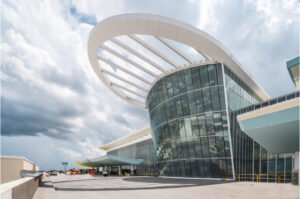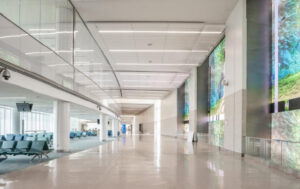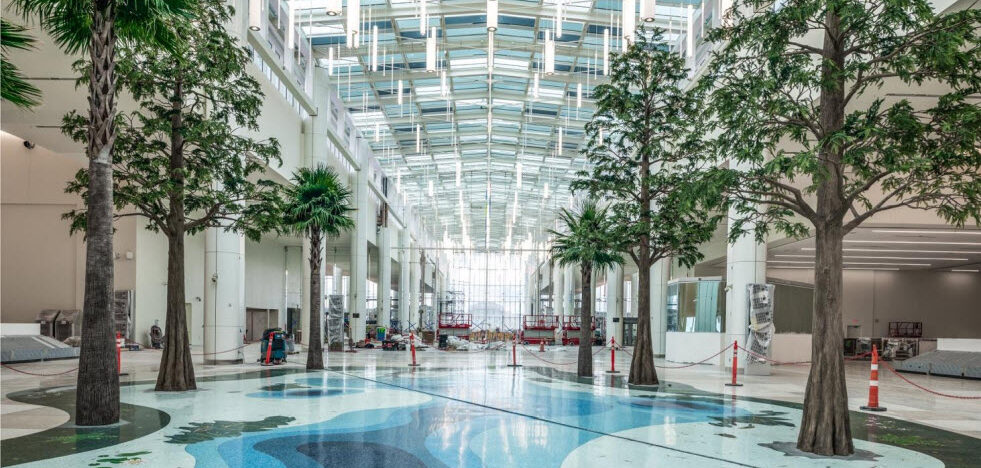Orlando International Airport (MCO) in Florida has released images of its US$2.8bn Terminal C, which is set to open this summer.
Spanning 167,225m2, Terminal C is expected to serve up to 12 million passengers annually and feature a new Federal Inspection Service (FIS) facility as well as 15 new gates (accommodating up to 20 aircraft), along with amenities including a nursing station and pet relief areas. At full build-out, Terminal C will increase capacity at MCO to 60 million passengers annually. Arriving international passengers will be directed to a sky bridge on the upper level of the concourse, which will take them to the new Federal Inspection Service facility.
Design architects Fentress Architects and the Howard, Needles, Tammen and Bergendoff (HNTB) firm, designed Terminal C. Among the terminal’s architectural elements is The Prow, which sets an uplifting tone at the curbside, especially when seen against a dramatic Florida sky. The ambient natural light that will flow in from this curbside curtainwall, as well as from the terminal’s skylit spine, has been designed to help bring the outdoors in, and guide passengers to amenities and onto their gates. All major building elements – ticketing, security, concessions, gates and baggage claim – will be aligned along The Boulevard, which will lead passengers on a linear journey. The Boulevard will be adorned with a skylight that supports foliage.

The Boulevard also will connect Terminal C’s two civic spaces – Palm Court and Town Square – with the MCO’s train station (also known as the Intermodal Terminal Facility), which supports up to four rail systems including Brightline’s intercity service. Palm Court is located airside, at the terminus of The Boulevard skylight. As the grandest of Terminal C’s civic spaces, this vibrant location will feature shopping, experiential media, dining, socializing and relaxation lounges in a daylit, garden-like atmosphere. Retail and lofted airline clubs on the second story are designed to overlook Palm Court and its experiential media element, which will feature interactive environments that encourage engagement as travelers pass by. Meanwhile, Town Square is located landside, at the terminus of an elevated international arrivals corridor. This light-filled, spacious arrivals hall on the terminal’s upper-most level is intended to provide a sense of welcoming and openness to enhance the international and domestic passenger experience.

With the help of recently developed baggage conveyance technology, the traditional paradigm of arrivals on the lower level and departures on the upper level will be reversed at Terminal C. Passengers arriving – often from long flights – will be directed to the upper-most level of the terminal, which will feature views of the local natural environment, restrooms and concessions. Departing travelers are expected to have a similarly intuitive experience with new parking and drop-off areas, a ticketing hall and security. The Experiential Media Environment (EME) has also been integrated into Terminal C’s architecture.
International and domestic passenger growth at MCO will be supported by an increasingly touchless experience. Terminal C was designed in a linear/pier configuration, which minimizes transit times for departing passengers to an average of 11 minutes. Additionally, Terminal C will engage a variety of biometric devices including 100% automated screening lanes at the TSA checkpoint and 100% facial recognition at all 15 gates for international arrivals and departures.
To help Terminal C be sustainable, the airport will deploy reduced water consumption and irrigation systems, responsive lighting and temperature control systems, solar panels and non-toxic adhesives and non-painted natural materials. Together, these and other strategies are intended to support an award of Silver or Gold LEED Certification by the US Green Building Council. If awarded, Terminal C will be the first LEEDv4 airport campus of any level in the world.
Curtis Fentress, a fellow of the American Institute of Architects (FAIA) and principal in charge of design with design architect Fentress Architects, said, “This summer, MCO will debut Terminal C, which is designed to support growing passenger volume and reinforce the airport’s reputation for excellence in traveler satisfaction. The tinted glass panels of the grand skylight dapple and diffuse sunlight, which creates an effect reminiscent of light coming through Orlando’s historic orange groves.”
Kevin Thibault, CEO of Greater Orlando Aviation Authority (GOAA), said, “Innovation and sophisticated design that reflect elements of the Central Florida community combine to deliver a world-class travel experience. Terminal C will be so much more than a transfer point from one place to another. It will serve as a multimodal, memorable entryway for passengers visiting, living and working in the region.”


